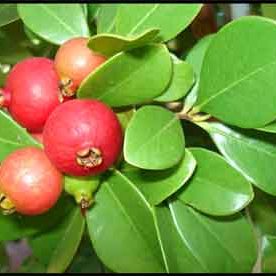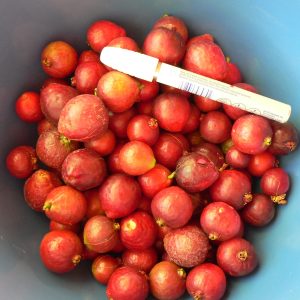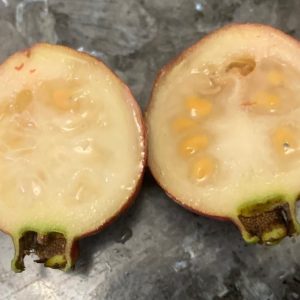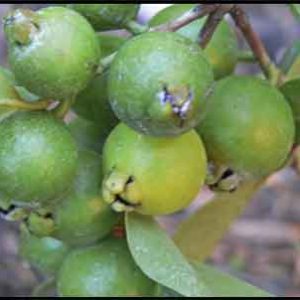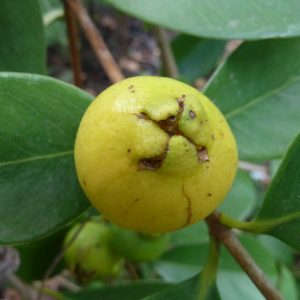Psidium cattleyanum (littorale)
Cherry Guava, strawberry guava, Cattley guava
Origin
Indigenous to lowlands of Eastern Brazil and Uruguay, and now grown in many tropical and sub-tropical countries worldwide.
Climate
This is a sub-tropical plant requiring ample precipitation, growing up to 1300m and at higher elevations in the tropics. It grows so well in these areas that in many countries it has been declared an invasive species. There is some tolerance of drought and moderate frosts.
Plant Description
The species is an attractive slow-growing evergreen shrub or small tree, 2-10m tall. The simple entire dark green glossy leaves are opposite, pink-bronze when young, elliptic-obovate, 4-8cm long and 2-4cm wide. There are three forms of the species, the most common producing red fruit and the others yellow and purple.
Relatives
Myrtaceae Family. Relatives include the common guava, and many others such as the Syzygiums, Eugenias, feijoa, pitanga and jaboticaba.
Soils
Undemanding and covering a pH range of 4-7.5, but will do best in well-drained fertile sandy or loamy soils. It can survive, although sub-optimally, in poor or calcareous soils that would not be suitable for many other fruit trees.
Propagation
They can be propagated by seed, grafting, budding or cuttings, with seed being the most common. Although seedling variation appears limited, superior selections should be propagated vegetatively. Low seed count is one favoured attribute for selection.
Cultivars
Little developmental work has been done with the species so there are no named rootstocks or cultivars and grafted plants are on their own seedlings.
Flowering and Pollination
Flowers are axillary, usually solitary but sometimes in clusters of 2-3, with 4-5 lobed sepals, white petals, prominent stamens 2cm long, and a 4-loculed inferior ovary with about 10 ovules, a slender style and dry stigma. There are no nectaries, but osmophores emit aromas attractive to pollinators, mainly bees. Flowers open at dawn and only last a day. The species is a facultative diplosporic apomict; it requires pollination for fruit set, which very rarely is by formation of a sexually produced zygote, but more usually follows parthenogenic development of an unreduced (non-haploid) megaspore mother cell. Fertilisation of the central cell forms a primitive endosperm but this quickly degenerates. Apomixis results in seedlings being essentially true to type and underlies ecological invasiveness of the species. There are varying levels of polyploidy in the species, with diploids unknown.
Cultivation
It should be planted in full sun. Irrigation during any dry periods that coincide with fruit set and development improves fruit size and yield. After establishment they usually need minimal fertilization as they form effective mycorrhizal associations which contribute to their self-sufficiency. Nevertheless, N application 3 months after harvest triggers offseason flowering and fruiting.
Wind Tolerance
Quite good.
Pruning
They require minimal pruning once a framework is established when young, and thereafter to maintain height at no more than 2-3m for ease of harvesting and spraying.
The Fruit
The fruit is a globose thin-skinned berry, 2.5-4cm diameter, green turning yellow, red or purple when mature. Flesh is translucent and white to cream coloured depending on variety. The pulp is fragrant, juicy, sweet to sub-acid and in some slightly astringent, and surrounds many small hard edible seeds, 2mm long. The yellow fruited form is generally the sweetest with least acidity.
Fruit Production and Harvesting
Production from seed takes 2-3 years and yield will then steadily increase over a number of years. Fruit maturity is staggered over several weeks. While there may be more than one crop per year the main one is in late Summer. They are regular and reliable bearers; for a small plant the yield is impressive. Fruit should be picked every 2-3 days. Storage life is very short.
Fruit Uses
Usually eaten fresh, but also processed into jams, jellies, beverages, ice-cream and other desserts. All parts of the fruit are usually eaten apart from the calyx remnants. Once picked, they are highly perishable and last only 3-4 days at room temperature. The flesh has good levels of Ca, Mg and vitamin C, and contains 5-17% carbohydrates.
Pests and Diseases
Med fly attacks the fruit and this will inevitably have to be controlled. Thrips may also be a problem. Birds.
Comments
This is a low maintenance vigorous plant with dense green foliage that is very attractive. It can be grown in a pot or pruned as a hedge that still fruits well. It has a preference for dry rather than unduly moist conditions which meshes well with our climate. It crops so well that unless you’re feeding a football team or prepared to do lots of processing, prune hard to contain size and yield.

